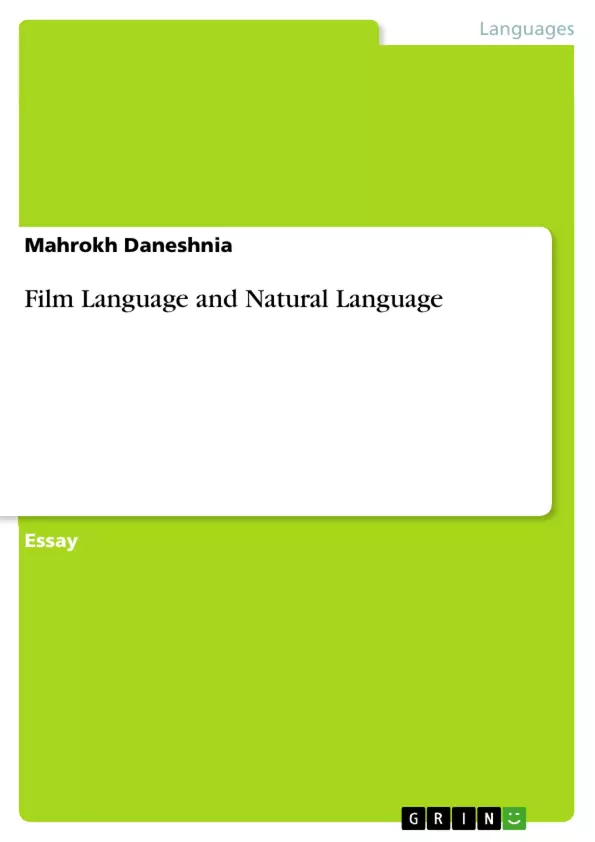The language of film is unlike any existing natural or verbal language as the meaning in natural language comes from a system of conventional signs and symbols, while in film there are no conventional meanings to grasp from cinematic images. This essay analyses some of the main arguments in film language regarding the similarities and differences between film language and verbal language.
Table of Contents
- Film Language and Natural Language
Objectives and Key Themes
This essay analyzes the arguments surrounding the similarities and differences between film language and verbal language. It examines various film theorists' perspectives on whether film can be considered a language and how its "language" functions compared to natural language.
- The comparison of film language to natural language
- Different theoretical approaches to understanding film language
- The role of montage and editing in creating meaning in film
- The differences between denotation and connotation in film versus verbal language
- The concept of "medium specificity" in film language
Chapter Summaries
Film Language and Natural Language: This chapter explores the central question of whether film possesses its own language, distinct from natural language. It delves into the theories of various influential film theorists, including Pudovkin, Eisenstein, Mitry, Bataille, Metz, and Currie. Pudovkin's "bricklaying" theory, comparing shots to words and sequences to sentences, is contrasted with Eisenstein's concept of montage as a collision of "montage cells" creating meaning through juxtaposition. Mitry argues for a "second-degree" language in film, where images are primary, and their arrangement creates a system of signs. Bataille focuses on the single shot's effect, acknowledging its dependence on context. Metz applies Saussurean semiotics, distinguishing between denotation and connotation, highlighting the lack of conventional denotation in film images. Finally, Currie emphasizes the "medium specificity" of film, its reliance on visual conveyance, and the crucial differences between the productivity and conventionality of natural language and the "nonatomic" nature of film images. The chapter concludes by emphasizing the significant distinctions between film language and natural language, arguing that film's artistic expression has its unique linguistic characteristics.
Keywords
Film language, natural language, semiotics, montage, editing, cinematic conventions, denotation, connotation, medium specificity, productivity, conventionality.
Frequently Asked Questions: A Comprehensive Language Preview
What is the main topic of this essay?
The essay analyzes the similarities and differences between film language and natural language. It explores whether film can be considered a language and how its “language” functions compared to verbal language.
What are the key themes explored in the essay?
Key themes include the comparison of film language to natural language; different theoretical approaches to understanding film language; the role of montage and editing in creating meaning; the differences between denotation and connotation in film versus verbal language; and the concept of "medium specificity" in film language.
Which film theorists are discussed in the essay?
The essay discusses the theories of several influential film theorists, including Pudovkin, Eisenstein, Mitry, Bataille, Metz, and Currie. Their perspectives on film language and its relationship to natural language are compared and contrasted.
What is Pudovkin's contribution to the discussion of film language?
Pudovkin's "bricklaying" theory compares shots to words and sequences to sentences, offering a structural analogy between film and verbal language.
What is Eisenstein's contribution to the discussion of film language?
Eisenstein's concept of montage emphasizes the creation of meaning through the juxtaposition of "montage cells," highlighting the dynamic and non-linear aspects of film's language.
What is Mitry's perspective on film language?
Mitry argues for a "second-degree" language in film, where the arrangement of images creates a system of signs, emphasizing the visual and compositional aspects of cinematic expression.
What is Bataille's focus in the context of film language?
Bataille concentrates on the effect of the single shot, acknowledging its dependence on its context within the broader film structure.
How does Metz apply semiotics to film?
Metz applies Saussurean semiotics to film, distinguishing between denotation and connotation and emphasizing the lack of conventional denotation in film images.
What is Currie's concept of "medium specificity"?
Currie emphasizes the "medium specificity" of film, its reliance on visual conveyance, and the crucial differences between the productivity and conventionality of natural language and the "nonatomic" nature of film images.
What is the conclusion of the essay regarding film language and natural language?
The essay concludes that while analogies can be drawn, there are significant distinctions between film language and natural language, and film's artistic expression possesses unique linguistic characteristics.
What are the keywords associated with this essay?
Keywords include: Film language, natural language, semiotics, montage, editing, cinematic conventions, denotation, connotation, medium specificity, productivity, conventionality.
- Quote paper
- Mahrokh Daneshnia (Author), 2013, Film Language and Natural Language, Munich, GRIN Verlag, https://www.grin.com/document/271494



